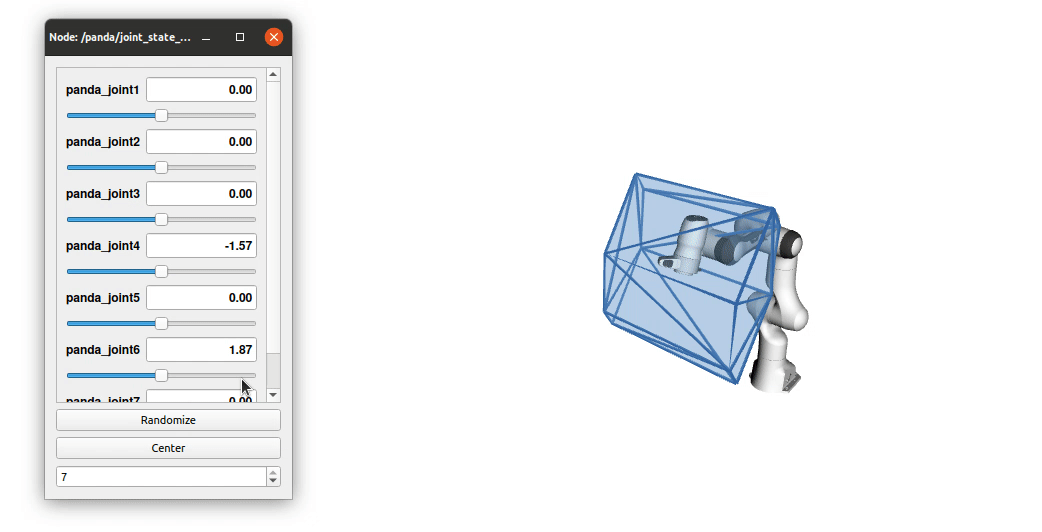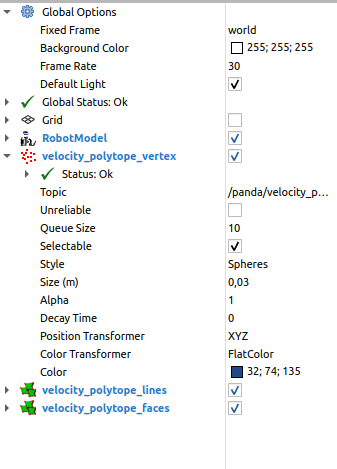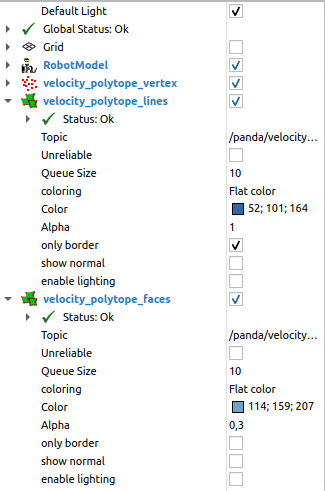ROS example using pinocchio

Interactive visualisation of the polytope in rviz using jsk_rviz_plugins package.
This is an example of using pycapacity with pinocchio and ROS.
The example is based on the panda robot.
The robot is loaded from the robot_description parameter.
The robot is visualised in rviz.
The polytope is visualised in rviz as well using jsk_rviz_plugins package and its message PolygonArray.
Robot model from robot_description
Getting the robot model from robot_description parameter is easy with pinocchio. Just use its build in function buildModelFromXML and construct the RobotWrapper class.
Then we can use the RobotWrapper class to calculate forward kinematics, jacobians, etc.
#!/usr/bin/env python
import rospy
# time evaluation
import time
#some math
import numpy as np
# joint state message
from sensor_msgs.msg import JointState
# URDF parsing an kinematics
import pinocchio as pin
# initial joint positions
joint_positions = [0,0,0,0,0,0,0]
# function receiveing the new joint positions
def callback(data):
global joint_positions
joint_positions = np.array(data.position)
# main function of the class
def vel_polytope():
global joint_positions
rospy.init_node('vel_polytope')
# loading the root urdf from robot_description parameter
robot = pin.RobotWrapper(model=pin.buildModelFromXML(rospy.get_param("robot_description")))
# end-effector frame id
ee_frame_id = robot.model.getFrameId("panda_link8")
# joint state topic
rospy.Subscriber('joint_states', JointState, callback, queue_size= 2)
rate = rospy.Rate(15) #Hz
while not rospy.is_shutdown():
if np.sum(joint_positions):
robot.forwardKinematics(joint_positions)
print(f"robot's end-effector position: {robot.data.oMf[ee_frame_id].translation}")
rate.sleep()
# class definition
if __name__ == '__main__':
try:
vel_polytope()
except rospy.ROSInterruptException:
pass
Calculating the polytope using pycapacity
The polytope is calculated using pycapacity package. To do so we need to calculate the jacobian matrix of the robot as well as the maximal joint velocities.
The maximal joint velocities are taken from the robot model. The jacobian matrix is calculated using pinocchio.
#!/usr/bin/env python
import rospy
# time evaluation
import time
#some math
import numpy as np
# joint state message
from sensor_msgs.msg import JointState
# URDF parsing an kinematics
import pinocchio as pin
# import pycapacity robot
from pycapacity.robot import *
# initial joint positions
joint_positions = [0,0,0,0,0,0,0]
# function receiveing the new joint positions
def callback(data):
global joint_positions
joint_positions = np.array(data.position)
def plot_polytope(robot, q, frame_name = None, scaling_factor = 10):
# if no joint state received, return
if not np.sum(q):
return
# if frame not specified, use the last frame
if frame_name is None:
frame_name = robot.model.frames[-1].name
# calculate forward kinematics of the robot
robot.forwardKinematics(q)
ee_position = robot.data.oMf[robot.model.getFrameId(frame_name)].translation
# calculate jacobi matrix
robot.computeJointJacobians(q)
J = pin.getFrameJacobian(robot.model, robot.data, robot.model.getFrameId(frame_name) , pin.ReferenceFrame.LOCAL_WORLD_ALIGNED)
# only position part
J = J[:3,:]
# maximal joint angles
dq_max = robot.model.velocityLimit.T
dq_min = -dq_max
# calculate force vertexes
start = time.time()
poly = velocity_polytope(J, dq_max, dq_min)
poly.find_faces()
velocity_vertex, velocity_faces = poly.vertices, poly.faces
# print time and number of vertices
print("Time to calculate polytope: ", time.time() - start)
print("Number of vertices: ", velocity_vertex.shape[1])
# main function of the class
def vel_polytope():
global joint_positions
rospy.init_node('vel_polytope')
# loading the root urdf from robot_description parameter
robot = pin.RobotWrapper(model=pin.buildModelFromXML(rospy.get_param("robot_description")))
# joint state topic
rospy.Subscriber('joint_states', JointState, callback, queue_size= 2)
rate = rospy.Rate(15) #Hz
while not rospy.is_shutdown():
plot_polytope(robot, joint_positions, frame_name="panda_link8")
rate.sleep()
# class definition
if __name__ == '__main__':
try:
vel_polytope()
except rospy.ROSInterruptException:
pass
Adding polytope visualisation using jsk_rviz_plugins
The polytope is visualised in rviz as well using jsk_rviz_plugins package and its message PolygonArray. The message contains the vertices of the polytope as well as the faces.
To install jsk_rviz_plugins package, follow the instructions on the jsk-ros-pkg website.
sudo apt install ros-*-jsk-rviz-plugins # melodic/kinetic... your ros version
Two utility functions are defined to create the vertex and faces messages.
# polytope messages
from sensor_msgs.msg import JointState, PointCloud
from jsk_recognition_msgs.msg import PolygonArray
from geometry_msgs.msg import Polygon, Point32, PolygonStamped
from std_msgs.msg import Header
# visualisation of vertices
def create_vertex_msg(force_vertex, pose, frame, scaling_factor = 500):
pointcloud_massage = PointCloud()
for i in range(force_vertex.shape[1]):
point = Point32()
point.x = force_vertex[0,i]/scaling_factor + pose[0]
point.y = force_vertex[1,i]/scaling_factor + pose[1]
point.z = force_vertex[2,i]/scaling_factor + pose[2]
pointcloud_massage.points.append(point)
# polytop stamped message
pointcloud_massage.header = Header()
pointcloud_massage.header.frame_id = frame
pointcloud_massage.header.stamp = rospy.Time.now()
return pointcloud_massage
# visualisation of polytope faces
def create_polytopes_msg(force_polytopes, pose, frame, scaling_factor = 500):
polygonarray_message = PolygonArray()
polygonarray_message.header = Header()
polygonarray_message.header.frame_id = frame
polygonarray_message.header.stamp = rospy.Time.now()
for face_polygon in force_polytopes:
polygon_massage = Polygon()
for i in range(face_polygon.shape[1]):
point = Point32()
point.x = face_polygon[0,i]/scaling_factor + pose[0]
point.y = face_polygon[1,i]/scaling_factor + pose[1]
point.z = face_polygon[2,i]/scaling_factor + pose[2]
polygon_massage.points.append(point)
# polytope stamped message
polygon_stamped = PolygonStamped()
polygon_stamped.polygon = polygon_massage
polygon_stamped.header = Header()
polygon_stamped.header.frame_id = frame
polygon_stamped.header.stamp = rospy.Time.now()
polygonarray_message.polygons.append(polygon_stamped)
polygonarray_message.likelihood.append(1.0)
return polygonarray_message
Once you have the message, you can add the jsk_rviz_plugins plugin to rviz and subscribe to the topic. The result is shown in the figure below.

Configuration of the display of polytope vertices in rviz.

Configuration of the display of polytope faces in rviz using jsk_rviz_plugins package PolygonArray message. We suggest using separate visualisation for faces and edges
Full code of the ROS node
The full code of the ROS node is shown below.
#!/usr/bin/env python
import rospy
# time evaluation
import time
#some math
import numpy as np
# URDF parsing an kinematics
import pinocchio as pin
# import pycapacity robot
from pycapacity.robot import *
# polytope messages
from sensor_msgs.msg import JointState, PointCloud
from jsk_recognition_msgs.msg import PolygonArray
from geometry_msgs.msg import Polygon, Point32, PolygonStamped
from std_msgs.msg import Header
# visualisation of vertices
def create_vertex_msg(force_vertex, pose, frame, scaling_factor = 500):
pointcloud_massage = PointCloud()
for i in range(force_vertex.shape[1]):
point = Point32()
point.x = force_vertex[0,i]/scaling_factor + pose[0]
point.y = force_vertex[1,i]/scaling_factor + pose[1]
point.z = force_vertex[2,i]/scaling_factor + pose[2]
pointcloud_massage.points.append(point)
# polytop stamped message
pointcloud_massage.header = Header()
pointcloud_massage.header.frame_id = frame
pointcloud_massage.header.stamp = rospy.Time.now()
return pointcloud_massage
# visualisation of polytope faces
def create_polytopes_msg(force_polytopes, pose, frame, scaling_factor = 500):
polygonarray_message = PolygonArray()
polygonarray_message.header = Header()
polygonarray_message.header.frame_id = frame
polygonarray_message.header.stamp = rospy.Time.now()
for face_polygon in force_polytopes:
polygon_massage = Polygon()
for i in range(face_polygon.shape[1]):
point = Point32()
point.x = face_polygon[0,i]/scaling_factor + pose[0]
point.y = face_polygon[1,i]/scaling_factor + pose[1]
point.z = face_polygon[2,i]/scaling_factor + pose[2]
polygon_massage.points.append(point)
# polytope stamped message
polygon_stamped = PolygonStamped()
polygon_stamped.polygon = polygon_massage
polygon_stamped.header = Header()
polygon_stamped.header.frame_id = frame
polygon_stamped.header.stamp = rospy.Time.now()
polygonarray_message.polygons.append(polygon_stamped)
polygonarray_message.likelihood.append(1.0)
return polygonarray_message
# initial joint positions
joint_positions = [0,0,0,0,0,0,0]
# function receiveing the new joint positions
def callback(data):
global joint_positions
joint_positions = np.array(data.position)
def plot_polytope(robot, q, frame_name = None, scaling_factor = 10):
# if no joint state received, return
if not np.sum(q):
return
# if frame not specified, use the last frame
if frame_name is None:
frame_name = robot.model.frames[-1].name
# calculate forward kinematics of the robot
robot.forwardKinematics(q)
ee_position = robot.data.oMf[robot.model.getFrameId(frame_name)].translation
# calculate jacobi matrix
robot.computeJointJacobians(q)
J = pin.getFrameJacobian(robot.model, robot.data, robot.model.getFrameId(frame_name) , pin.ReferenceFrame.LOCAL_WORLD_ALIGNED)
# only position part
J = J[:3,:]
# maximal joint angles
dq_max = robot.model.velocityLimit.T
dq_min = -dq_max
# calculate force vertexes
start = time.time()
poly = velocity_polytope(J, dq_max, dq_min)
poly.find_faces()
velocity_vertex, velocity_faces = poly.vertices, poly.faces
print(time.time() - start)
# publish vertices
publish_polytope_vertex = rospy.Publisher('velocity_polytope_vertex', PointCloud, queue_size=10)
publish_polytope_vertex.publish(create_vertex_msg(velocity_vertex, ee_position, "world", scaling_factor))
# publish polytope
publish_polytope = rospy.Publisher('velocity_polytope', PolygonArray, queue_size=10)
publish_polytope.publish(create_polytopes_msg(velocity_faces, ee_position, "world", scaling_factor))
# main function of the class
def vel_polytope():
global joint_positions
rospy.init_node('vel_polytope')
# loading the root urdf from robot_description parameter
robot = pin.RobotWrapper(model=pin.buildModelFromXML(rospy.get_param("robot_description")))
# joint state topic
rospy.Subscriber('joint_states', JointState, callback, queue_size= 2)
rate = rospy.Rate(15) #Hz
while not rospy.is_shutdown():
plot_polytope(robot, joint_positions, frame_name="panda_link8")
rate.sleep()
# class definition
if __name__ == '__main__':
try:
vel_polytope()
except rospy.ROSInterruptException:
pass

Interactive visualisation of the polytope in rviz using jsk_rviz_plugins package.